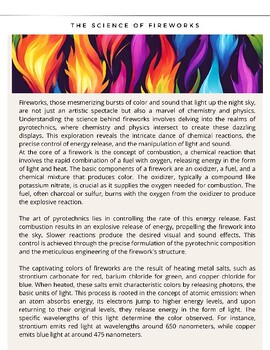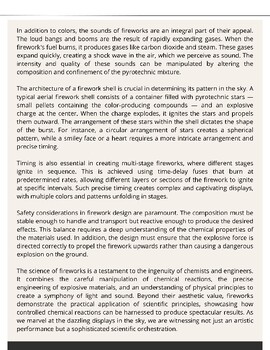Fireworks SAT Passage with Questions and Key
The Chemist's Tree
1 Follower
Grade Levels
9th - 12th
Subjects
Resource Type
Standards
CCSSRI.11-12.1
CCSSRI.11-12.2
CCSSRI.11-12.5
NGSSHS-PS1-1
NGSSHS-PS1-2
Formats Included
- PDF
The Chemist's Tree
1 Follower
Description
An anchoring phenomenon of fireworks, the article is made in an SAT style and includes a set of questions with answer key.
Great addition to any electron unit, including electron configuration or photoelectric effect.
Works well for a substitute, opening assignment, homework, cross curricular, or WICOR assignment.
Total Pages
Answer Key
N/A
Teaching Duration
N/A
Report this resource to TPT
Reported resources will be reviewed by our team. Report this resource to let us know if this resource violates TPT’s content guidelines.
Standards
to see state-specific standards (only available in the US).
CCSSRI.11-12.1
Cite strong and thorough textual evidence to support analysis of what the text says explicitly as well as inferences drawn from the text, including determining where the text leaves matters uncertain.
CCSSRI.11-12.2
Determine two or more central ideas of a text and analyze their development over the course of the text, including how they interact and build on one another to provide a complex analysis; provide an objective summary of the text.
CCSSRI.11-12.5
Analyze and evaluate the effectiveness of the structure an author uses in his or her exposition or argument, including whether the structure makes points clear, convincing, and engaging.
NGSSHS-PS1-1
Use the periodic table as a model to predict the relative properties of elements based on the patterns of electrons in the outermost energy level of atoms. Examples of properties that could be predicted from patterns could include reactivity of metals, types of bonds formed, numbers of bonds formed, and reactions with oxygen. Assessment is limited to main group elements. Assessment does not include quantitative understanding of ionization energy beyond relative trends.
NGSSHS-PS1-2
Construct and revise an explanation for the outcome of a simple chemical reaction based on the outermost electron states of atoms, trends in the periodic table, and knowledge of the patterns of chemical properties. Examples of chemical reactions could include the reaction of sodium and chlorine, of carbon and oxygen, or of carbon and hydrogen. Assessment is limited to chemical reactions involving main group elements and combustion reactions.





